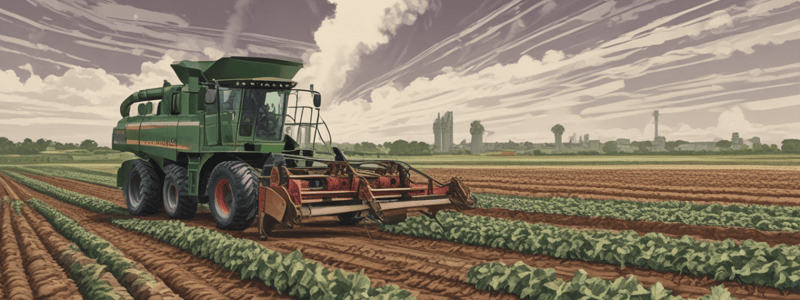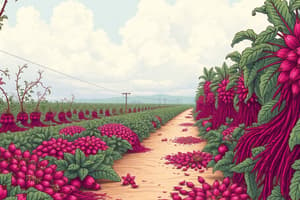Podcast
Questions and Answers
What is the duration of the sugar beet harvesting campaign?
What is the duration of the sugar beet harvesting campaign?
What happens to the leaves of the sugar beet plants?
What happens to the leaves of the sugar beet plants?
How are the sugar beets transported from the harvested field?
How are the sugar beets transported from the harvested field?
What is measured at the weighbridge?
What is measured at the weighbridge?
Signup and view all the answers
What is the purpose of taking a sample of the load?
What is the purpose of taking a sample of the load?
Signup and view all the answers
How is the farmer paid?
How is the farmer paid?
Signup and view all the answers
What happens to the load after it is weighed and sampled?
What happens to the load after it is weighed and sampled?
Signup and view all the answers
What is the reception area typically made of?
What is the reception area typically made of?
Signup and view all the answers
What is the purpose of checking the beet sample for nitrogen content?
What is the purpose of checking the beet sample for nitrogen content?
Signup and view all the answers
How is the beet transferred from the silos to the factory?
How is the beet transferred from the silos to the factory?
Signup and view all the answers
What is the purpose of the stone and grass catchers?
What is the purpose of the stone and grass catchers?
Signup and view all the answers
What is the percentage of sugar in the raw juice?
What is the percentage of sugar in the raw juice?
Signup and view all the answers
What is the colour of the raw juice?
What is the colour of the raw juice?
Signup and view all the answers
What happens to the exhausted beet slices?
What happens to the exhausted beet slices?
Signup and view all the answers
What is the purpose of diffusing the beet with hot water?
What is the purpose of diffusing the beet with hot water?
Signup and view all the answers
What is the shape of the beet slices before extraction?
What is the shape of the beet slices before extraction?
Signup and view all the answers
What is the primary purpose of juice purification in the sugar production process?
What is the primary purpose of juice purification in the sugar production process?
Signup and view all the answers
What is the byproduct of sugar production that is used as fertilizer or growth substrate for yeast cultures?
What is the byproduct of sugar production that is used as fertilizer or growth substrate for yeast cultures?
Signup and view all the answers
Why is formaldehyde added to the feed water during diffusion?
Why is formaldehyde added to the feed water during diffusion?
Signup and view all the answers
What is the primary purpose of carbonatation in sugar production?
What is the primary purpose of carbonatation in sugar production?
Signup and view all the answers
What is the result of operating diffusion under alkaline conditions?
What is the result of operating diffusion under alkaline conditions?
Signup and view all the answers
What is the purpose of controlling the feed water pH during diffusion?
What is the purpose of controlling the feed water pH during diffusion?
Signup and view all the answers
What is the result of the breakdown of sucrose into invert sugars during diffusion?
What is the result of the breakdown of sucrose into invert sugars during diffusion?
Signup and view all the answers
What is the purpose of adding lime and carbon dioxide gas to the juice during juice purification?
What is the purpose of adding lime and carbon dioxide gas to the juice during juice purification?
Signup and view all the answers
Study Notes
Sugar Production from Sugar Beet
- Harvesting of sugar beet, also known as the "campaign", takes place from late September to mid-January, and is a continuous process.
- Mechanical harvesting methods are used to remove the beet from the ground, clean it, and cut off the top of the plants.
- The leaves are a valuable source of animal feed, equal in value to one acre of turnips.
Weighing and Sampling
- Lorries carrying sugar beets drive over a weighbridge to measure their gross weight.
- A sample of the load is taken to determine the sugar percentage and the amount of tare (clay, stones, beet tops, etc.) in the overall load.
- The farmer is paid a predetermined price per ton of clean beet delivered based on a sliding scale related to sugar content.
Reception
- Each load is weighed and sampled before being tipped onto a reception area, where it is moved into large heaps.
- The beet sample is checked for soil tare, crown tare, sugar content ("pol"), and nitrogen content.
Unloading
- There are two systems of unloading: dry unloading and wet unloading.
- In dry unloading, the beet is conveyed from the lorry to open air silos, where it is stored.
- In wet unloading, the beet is washed from the lorry by a powerful jet of water and transferred to the factory by water.
Diffusion
- The actual sugar is extracted from the beet by diffusing it out with hot water in a large vessel.
- Sugar is extracted from the beet in the form of a solution, referred to as the raw juice, which contains about 14% sugar and is black in color.
- The exhausted beet slices, or pulp, are mixed with molasses, then dried and sold as an animal feed.
Saturation
- At the diffusion stage, other substances are extracted from the beet, including non-sugars.
- Juice purification is necessary to remove these non-sugars and produce white crystalline sugar.
- Lime and carbon dioxide gas are used to remove impurities from the juice, resulting in a light yellow color.
Studying That Suits You
Use AI to generate personalized quizzes and flashcards to suit your learning preferences.
Related Documents
Description
This quiz covers the harvesting of sugar beets and the production of sugar from them. It includes information on the harvesting process, also known as the 'campaign', which typically takes place from September to January.




